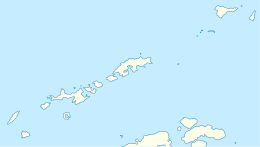Deception Island
 Satellite image of the island bySentinel-2(March 2023) | |
| Geography | |
|---|---|
| Location | Antarctica |
| Coordinates | 62°57′30″S60°38′30″W/ 62.95833°S 60.64167°W |
| Area | 79 km2(31 sq mi) |
| Length | 12 km (7.5 mi) |
| Width | 12 km (7.5 mi) |
| Highest elevation | 542 m (1778 ft) |
| Highest point | Mount Pond |
| Administration | |
| Administered under theAntarctic Treaty System | |
| Demographics | |
| Population | 0 |
| Surgidero Iquique Lighthouse | |
| Construction | concrete (foundation), fiberglass (tower) |
| Height | 4.5 m (15 ft) |
| Shape | cylinder |
| Markings | stripe (white, orange, horizontal direction) |
| Power source | solar power |
| Focal height | 114 m (374 ft) |
| Range | 5 nmi (9.3 km; 5.8 mi) |
| Characteristic | Fl W 5s |

Deception Islandis in theSouth Shetland Islandsclose to theAntarctic Peninsulawith a large and usually "safe" natural harbor, which is occasionally affected by the underlying active volcano.[1][better source needed]This island is thecalderaof an activevolcano,which seriously damaged local scientific stations in 1967 and 1969. The island previously held a whaling station. It is now a tourist destination with over 15,000 visitors per year.[citation needed]Two research stations are operated by Argentina and Spain during the summer season.[2]While various countries have asserted sovereignty, it is still administered under theAntarctic Treaty System.
Geography
[edit]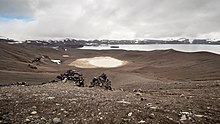

Located within theBransfield Strait,the island is roughly circular and horseshoe-shaped, with a maximum diameter around 15 km (9.3 mi). The highest peak, Mount Pond on the east side of the island, has an elevation of 539 m (1,768 ft), while Mount Kirkwood on the west has an elevation of 452 m (1,483 ft). Over half (57%) of the island is covered byglaciersup to 10 m thick, ice-coredmoraines,or ice-coveredpyroclasts.The centre of the island has been flooded by the sea to form a large bay, now calledPort Foster,about 10 km (6.2 mi) long and 7 km (4.3 mi) wide. The bay has a narrow entrance, just 500 m (1,640 ft) wide, calledNeptune's Bellows.The port is abasinwith a flat floor up to 170 m (560 ft) deep with several small submarineconesanddomes.The port is rimmed by a shallowcoastal shelfwith sandy-gravellybeaches. The outer coast of the island is characterized by 30–70 m (98–230 ft) cliffs of rock or ice.[3]
Raven's Rock, a navigation hazard, lies 2.5 m (8.2 ft) below the water in the middle of the channel. Just inside Neptune's Bellows lies the coveWhalers Bay,which is bordered by a largeblack sandbeach. Severalmaarsline the inside rim of the caldera, with some containingcrater lakes(including one named Crater Lake). Others form bays within the harbour, such as the 1 km (0.6 mi) wide Whalers Bay. Other features of the island includeMount Kirkwood,Fumarole Bay,Sewing-Machine Needles,Telefon Bay,andTelefon Ridge.
The linearCosta Rectaspanning most of the east coast is hypothesised to be a scarp of a retreated submarine fault.[4]
A 2016 study onArdley Island,120 km (75 mi) to the northeast, examined lake guano sediments and studied penguin population dynamics over 7,000 years. Three of five population growth phases were terminated by a sudden crash, due to volcanic eruptions from the active volcano of Deception Island.[5][6] The history of volcanic eruptions is still under investigation, but several larger eruptions happened in the last 10,000 years.[7]
Geology
[edit]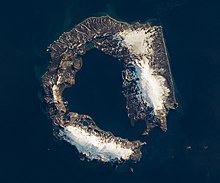
Deception Island is the exposed portion of an activeshield volcano30 km in diameter. The island is associated withBransfield Basinseafloor spreadingthat includes a volcanic ridge andseamountsdating back to thePleistocene.Deception Islandvolcanic ashlayers have been found on other South Shetland Islands, the Bransfield Strait, the Scotia Sea and in South Poleice cores.Volcanic tremorsare common, originating from depths less than 10 km. Historical eruptions occurred in 1839–1842, 1967, 1969, and 1970.[3]: iii Stratigraphyof the island is characterized by the pre-calderaPort Foster Group and the post-caldera Mount Pond Group, both within the Deception Island Volcanic Complex. The Port Foster Group's principaloutcropsare located at South Point, Cathedral Crags near Entrance Point and north of Punta de la Descubierta forming spectacular coastal cliffs along the western portion of the island. The group is composed of the Fumarole Bay Formation consisting ofhydrovolcanictephra,the Basaltic Shield Formation consisting oflavasandStrombolianscoria,and the Outer CoastTuffFormationconsisting oflapilli-tuffs. The Mount Pond Group dominates the surface geology and consists of thepyroclasticBaily Head and Pendulum Cove formations, both formed during hydrovolcanic eruptions, and the Stonethrow Ridge Formation consisting of tuffconeandmaardeposits. The caldera collapsed as either a hydrovolcanic eruption of the Outer Coast Tuff Formation, releasing about 30cubic kilometersofmagma,or passively due to regionaltectonics,since the island is at the intersection of the Bransfield Straitriftand theorthogonalHero Fracture Zone.[8][9][10]
History
[edit]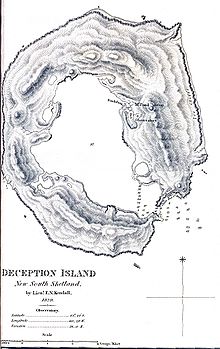
The first authenticated sighting of Deception Island was by the British sealers William Smith andEdward Bransfieldfrom thebrigWilliamsin January 1820. It was first visited and explored by the American sealerNathaniel Palmeron thesloopHerothe following summer, on 15 November 1820. He remained for two days, exploring the central bay.[11]Palmer named it "Deception Island" on account of its outwarddeceptiveappearance as a normal island, when the narrow entrance ofNeptune's Bellowsrevealed it rather to be a ring around a flooded caldera.[12][13]
Palmer was part of an American sealing fleet fromStonington, Connecticut,under the command of Benjamin Pendleton, consisting of 6 ships. Port Fisher was used as their operational base from 1820 to 1821. Palmer metBellingshausenclose to the island in Jan. 1821, during theFirst Russian Antarctic Expedition.[3]
A lighthouse namedSurgidero Iquiquewas built on the island to guide vessels intoDeception Station.[14][15]
Whaling and sealing
[edit]
Over the next few years, Deception became a focal point of the short-livedfur-sealingindustry in the South Shetlands. The industry began with a handful of ships in the 1819–1820 summer season, rising to nearly a hundred in 1821–1822. While the island did not have a large seal population, it was a perfect natural harbour, mostly free from ice and winds, and a convenient rendezvous point. Some men likely lived ashore in tents or shacks for short periods during the summer, though no archaeological or documentary evidence survives to confirm this. Massive overhunting meant that the fur seals neared extinction in the South Shetlands within a few years, and the sealing industry collapsed as quickly as it had begun. Deception was abandoned again in approximately 1825.[11]
Sealing captain Robert Fildes charted Port Foster in 1820–1821, which in 1829 became the first published Antarcticanautical chart.[3]
In 1829, the British Naval Expedition to the South Atlantic under the command ofCaptain Henry FosterinHMSChanticleerstopped at Deception. The expedition conducted a topographic survey and scientific experiments, particularly pendulum and magnetic observations.[16]A watercolour made by Lieutenant Kendall of theChanticleerduring the visit may be the first image made of the island.[11]A subsequent visit by the American elephant-sealerOhioin 1842 reported the first recorded volcanic activity, with the southern shore "in flames".[11]

The second phase of human activity at Deception began in the early 20th century. In 1904, an activewhalingindustry was established at South Georgia, taking advantage of new technology and an almost untouched population of whales to make rapid profits. It spread south into the South Shetland Islands, where the lack of shore-based infrastructure meant that the whales had to be towed to mooredfactory shipsfor processing; these needed a sheltered anchorage and a plentiful supply of fresh water, both of which could be found at Deception. In 1906, theNorwegian-Chileanwhaling company Sociedad Ballenera de Magallanes started usingWhalers Bayas a base for a single ship, theGobernador Bories.[11]
Other whalers followed, with several hundred men resident at Deception during the Antarctic summers and as many as 13 ships operating in peak years. In 1908, the British government formally declared the island to be part of theFalkland Islands Dependencies,thus under British control, establishing postal services and appointing a magistrate and customs officer for the island. The magistrate was to ensure that whaling companies were paying appropriate licence fees to the Falklands government and ensuring adherence to catch quotas. A cemetery was built in 1908, a radio station in 1912, a hand-operated railway also in 1912,[17]and a small permanent magistrate's house in 1914.[11] The cemetery, by far the largest in Antarctica, held graves for 35 men along with a memorial to 10 more presumed drowned.[18]
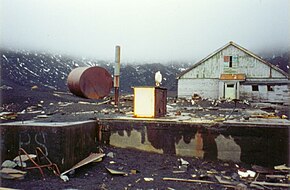
These were not the only constructions; as the factory ships of the period were only able to strip the blubber from whales and could not use the carcasses,a permanent on-shore station was established by the Norwegian company Hvalfangerselskabet Hektor A/Sin 1912 – up to an estimated 40% of the available oil was being wasted by the ship-based system. This was the only successful shore-based industry ever to operate in Antarctica, reaping high profits in its first years.[11]A number of exploring expeditions visited Deception during these years, including theWilkins-Hearst expeditionof 1928, when aLockheed Vegawas flown from a beach airstrip on the first successful flights in Antarctica.[11]
The development of pelagic whaling in the 1920s, where factory ships fitted with a slipway could tow aboard entire whales for processing, meant that whaling companies were no longer tied to sheltered anchorages. A boom in pelagic Antarctic whaling followed, with companies now free to ignore quotas and escape the costs of licences. This rapidly led to overproduction of oil and a collapse in the market, and the less profitable and more heavily regulated shore-based companies had trouble competing. In early 1931, the Hektor factory finally ceased operation, ending commercial whaling at the island entirely.[11]
Scientific research
[edit]On 16 November 1928,Hubert Wilkinsmade the first Antarctic flight from a Whalers Bay ash runway.[3]
Deception remained uninhabited for a decade, but was revisited in 1941 by the British auxiliary warshipHMSQueen of Bermuda,which destroyed the oil tanks and some remaining supplies to ensure it could not be used as a German supply base.[11]In 1942, an Argentine party aboard thePrimero de Mayovisited and left signs and painted flags declaring the site Argentine territory; the following year, a British party withHMSCarnarvon Castlereturned to remove the signs.[19]
In 1944, a British expedition under LieutenantJames Marr[20]established a short-lived base on Deception Island as part ofOperation Tabarin,which was carried out during theSecond World Warto deny safe anchorages to enemy raiding vessels and to gather meteorological data for allied shipping in the South Atlantic. It also had the effect of strengthening British claims to theFalkland Island Dependenciesthat had begun being challenged[21]byArgentinaandChile.Operation Tabarin would deny use of the area to theKriegsmarine,which was known to use remote islands as rendezvous points, and address a fear that Japan might attempt to seize theFalkland Islands.Following the end of the war, the research begun by Operation Tabarin continued in subsequent years, ultimately becoming theBritish Antarctic Survey.[22]
In February 1953, as part of a post-war British effort to exert sovereignty over its claimed Antarctic territories,HMSSnipe(U20)landed a party ofRoyal Marineson Deception Island to destroy an Argentinian and a Chilean military base; an action known as theDeception Island incident.[23]
In 1961,Argentina's presidentArturo Frondizivisited the island to show his country's interest. Regular visits were made by other countries operating in the Antarctic, including the 1964 visit of theUS Coast GuardicebreakerEastwind,which ran aground inside the harbour.[24]
However, the volcano returned to activity in 1967 and 1969, destroying the existing scientific stations. Both British and Chilean stations were demolished, and the island was again abandoned for several years. The final major volcanic eruption was reported by the Russian Bellingshausen station onKing George Islandand the Chilean station Arturo Prat onGreenwich Island;both stations experienced major falls of ash on 13 August 1970.[25](p 294)
In 2000, there were two summer-only scientific stations, the SpanishGabriel de Castilla Base[26]and the ArgentineDecepción Station.[27]
Remains of previous structures at Whalers Bay include rusting boilers and tanks, anaircraft hangar,and the British scientific station house (Biscoe House), with the middle torn out by the 1969 mudflows. A bright orange derelict airplanefuselage,which is that of ade Havilland Canada DHC-3 Otterthat belonged to theRoyal Air Force,was recovered in 2004. Plans to restore the airplane and return it to the island have been made.[27]
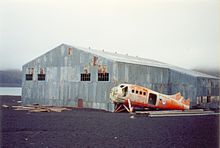
The Russian cruise shipMVLyubov Orlovaran aground at Deception Island on 27 November 2006.[28]She was towed off by the Spanish NavyicebreakerLas Palmasand made her own way toUshuaia,Tierra del Fuego.She later became aghost shipin the North Atlantic after the towing line parted during an operation to scrap the vessel in theDominican Republic.
Tourism
[edit]The firstcommercial cruise shiparrived in January 1966. By 1999, over 10,000 tourists had visited the island.[3]: 5
Research stations
[edit]Aguirre Cerda
[edit]President Pedro Aguirre Cerda Stationwas a Chilean Antarctic base, located atPendulum Coveon Deception Island in theSouth Shetland Islands,inaugurated in 1955. It was evacuated in December 1967 when volcanic eruptions forced the evacuation of the base.
Deception
[edit]Deception Stationis an Argentine base located at Deception Island. The station was founded on 25 January 1948 and was a year-round station until December 1967, whenvolcanic eruptionsforced the evacuation of the base. Since then, it has been inhabited only during the summer.
Gabriel de Castilla
[edit]
Gabriel de Castilla Baseis a Spanish research station located on Deception Island. The station was constructed in 1990.[29]
Gutiérrez Vargas Refuge
[edit]The Gutiérrez Vargas Refuge, named after an aviation captain who died on 30 December 1955, was located at 1 km (0.62 mi) from Aguirre Cerda Station and was inaugurated on 12 February 1956. Its purpose was to serve as a refuge for the members of the station in case of fire. On 4 December 1967 the refuge was definitively abandoned, as was the Aguirre Cerda Station, due to a violent volcanic eruption. The remains of the refuge structure can still be seen on the beach where it was located.[citation needed]
Station B
[edit]Station B | |
|---|---|
| Coordinates:62°58′38″S60°33′50″W/ 62.9772°S 60.5638°W | |
| Established | 1944 |
| Abandoned | 23 February 1969 |
| Government | |
| • Type | Administration |
| • Body | FIDASE,United Kingdom |
| Active times | All year-round |
In early 1944, a party of men fromOperation Tabarin,a British expedition, established a permanent scientific base named Station B.[30]This was occupied until 5 December 1967, when an eruption forced a temporary withdrawal. It was used again between 4 December 1968 and 23 February 1969, when further volcanic activity caused it to be abandoned.[25](p 291–292)
Environment
[edit]
Deception Island has become a popular tourist stop in Antarctica because of its several colonies ofchinstrap penguins,as well as the possibility of making a warm bath by digging into the sands of the beach.
After the Norwegian Coastal Cruise LinerMSNordkappran aground off the coast of Deception Island on 30 January 2007, fuel from the ship washed into a bay. Ecological damage has not yet been determined. On 4 February 2007, the Spanish Gabriel de Castilla research station on Deception Island reported that water and sand tests were clean, and that they had not found signs of the oil, estimated as 500 to 750Lof light diesel (130 to 200US gal;110 to 160imp gal).
Deception Island exhibits some wildly varyingmicroclimates.Near volcanic areas, the air can be as hot as 40 °C (104 °F), and water temperature can reach 70 °C (158 °F).[citation needed]
Antarctic specially protected areas
[edit]Eleven terrestrial sites have been collectively designated as anAntarctic specially protected area(ASPA 140), primarily for their botanic and ecological values, because the island has the greatest number of rare plant species of any place in the Antarctic. This is largely due to frequent volcanic activity creating new substrates for plant colonisation:[31]
- Collins Point(site A) contains good examples of long-established vegetation, with high species diversity and several rarities.
- Crater Lake(site B) has ascoria-coveredlava tonguewith a diversecryptogamicflora, and exceptional development ofturf-formingmosses.
- An unnamed hill at the southern end of Fumarole Bay (site C) has several rare species of mosses that have colonised the heated soil crust close to a line of volcanic vents.
- Fumarole Bay (site D) isgeologicallycomplex with the most diverse flora on the island.
- WestStonethrow Ridge(site E) supports several rare mosses,liverworts,andlichens.
- Telefon Bay(site F) has all its surfaces dating from 1967, thus allowing accurate monitoring of colonisation by plants and animals.
- Pendulum Cove(site G) is another known-age site being colonised by mosses and lichens.
- Mount Pond(site H) contains exceptional moss, liverwort, and lichencommunities.
- Perchue Cone (site J) is anash and cinder conewith rare mosses.
- Ronald HilltoKroner Lake(site K) is another known-age site being colonised by numerous cryptogam species, and with a uniquealgalcommunity on the lake shore.
- South East Point(site L) supports the most extensive population ofAntarctic pearlwortknown in the Antarctic region.
In addition, two marine sites inPort Fosterhave collectively been designated ASPA 145, to protect theirbenthiccommunities.[32]
Important bird area
[edit]Baily Head,a prominent headland forming the easternmost extremity of the island, has been identified as animportant bird area(IBA) byBirdLife Internationalbecause it supports a very largebreeding colonyofchinstrap penguins(100,000 pairs). The 78 ha (190-acre) IBA comprises the ice-free headland and about 800 metres (0.50 mi) of beach on either side of it. Other birds known to nest at the site includebrown skuas,Cape petrels,andsnowy sheathbills.[33]
See also
[edit]References
[edit]- ^Djajkovski, Petar (30 March 2017)."Deception Island: The" safest "harbor in Antarctica until it was abandoned in the 1960s".Abandoned Spaces.
- ^Geyer, A.; Álvarez-Valero, A.M.; Gisbert, G.; Aulinas, M.; Hernández-Barreña, D.; Lobo, A.; Marti, J. (23 January 2019)."Deciphering the evolution of Deception Island's magmatic system".Scientific Reports.9(1): 373.Bibcode:2019NatSR...9..373G.doi:10.1038/s41598-018-36188-4.ISSN2045-2322.PMC6344569.PMID30674998.
- ^abcdefgSmellie, J.L.; Lopez-Martinez, J. (2002). "Introduction". In Lopez-Martinez, J.; Smellie, J.L.; Thomson, J.W.; Thomson, M.R.A. (eds.).Geology and geomorphology of Deception Island.Bas Geomap Series. Cambridge: British Antarctic Survey. pp. 1–4.ISSN0951-8886.
- ^Fernández-Ibáñez, Fermín; Pérez-López, Raul; Martínez-Díaz, José J.; Paredes, Carlos; Giner-Robles, Jorge L.; Caselli, Alberto T.; Ibáñez, Jesús M. (2005)."Costa Recta beach, Deception Island, West Antarctica: A retreated scarp of a submarine fault?".Antarctic Science.17(3): 418.Bibcode:2005AntSc..17..418F.doi:10.1017/S0954102005002841.hdl:20.500.12110/paper_09541020_v17_n3_p418_FernandezIbanez.S2CID54090378.
- ^Amos, Jonathan (11 April 2017)."Poo sediments record Antarctic 'penguin Pompeii'".BBC News Online.
- ^Roberts, Stephen J.; Monien, Patrick; Foster, Louise C.; Loftfield, Julia; Hocking, Emma P.; Schnetger, Bernhard; et al. (2017)."Past penguin colony responses to explosive volcanism on the Antarctic Peninsula".Nature Communications.8(14914): 14914.Bibcode:2017NatCo...814914R.doi:10.1038/ncomms14914.PMC5394244.PMID28398353.
- ^Antoniades, Dermot; Giralt, Santiago; Geyer, Adelina; Álvarez-Valero, Antonio M.; Pla-Rabes, Sergi; Granados, Ignacio; et al. (2018)."The timing and widespread effects of the largest Holocene volcanic eruption in Antarctica".Scientific Reports.8(1): 17279.Bibcode:2018NatSR...817279A.doi:10.1038/s41598-018-35460-x.ISSN2045-2322.PMC6250685.PMID30467408.
- ^Smellie, J.L. (2002). "Geology". In Lopez-Martinez, J.; Smellie, J.L.; Thomson, J.W.; Thomson, M.R.A. (eds.).Geology and Geomorphology of Deception Island.Bas Geomap Series. Cambridge: British Antarctic Survey. pp. 11–30.ISSN0951-8886.
- ^Rey, J.; Maestro, A.; Somoza, L.; Smellie, J.L. (2002). "Submarine morphology and seismic stratigraphy of Port Foster". In Lopez-Martinez, J.; Smellie, J.L.; Thomson, J.W.; Thomson, M.R.A. (eds.).Geology and Geomorphology of Deception Island.Bas Geomap Series. Cambridge: British Antarctic Survey. p. 41.ISSN0951-8886.
- ^Gonzalez-Ferran, O. (1991). "The Bransfield rift and its active volcanism". In Thomson, M.R.A.; Crame, J.A.; Thomson, J.W. (eds.).Geological Evolution of Antarctica.Cambridge, UK: Cambridge University Press. pp. 508–509.ISBN9780521372664.
- ^abcdefghijDibbern, J. Stephen (2 September 2009). "Fur seals, whales and tourists: A commercial history of Deception Island, Antarctica".Polar Record.46(3): 210–221.doi:10.1017/S0032247409008651.S2CID140710046.
- ^Mills, William J. (2003).Exploring Polar Frontiers: A historical encyclopedia.Vol. 1.ABC Clio.p. 183.ISBN978-1-57607-422-0.
- ^"SCAR Composite Gazetteer".www.data.aad.gov.au.Retrieved28 August2017.
- ^ "The West Coasts of North and South America (excluding continental U.S.A. and Hawaii), Australia, Tasmania, New Zealand, and the Islands of the North and South Pacific Oceans".List of Lights (Report). U.S.National Geospatial-Intelligence Agency.2017. Pub. 111.
- ^Rowlett, Russ."Lighthouses of Antarctica".The Lighthouse Directory.University of North Carolina at Chapel Hill.Retrieved25 May2017.
- ^Fogg, Gordon Elliott (1992).A History of Antarctic Science.Cambridge, UK: Cambridge University Press. pp. 72–74.
- ^Williams, Glynn."Railways in Antarctica".Retrieved4 September2014.
- ^Measures adopted.The Antarctic Treaty 28th Consultative Meeting 6–17 June 2005. Stockholm, SE: United Kingdom Foreign and Commonwealth Affairs Office. July 2007. pp. 293–299. Command Paper 7166.Retrieved18 July2013.
- ^HMSCarnarvon Castle(photograph). Cambridge University. 1943.
- ^"Scott Polar Research Institute, Cambridge » Picture Library catalogue".www.spri.cam.ac.uk.Retrieved25 March2018.
- ^"About – British Antarctic Survey".www.antarctica.ac.uk.Retrieved25 March2018.
- ^"Operation Tabarin overview".British Antarctic Survey – Polar Science for Planet Earth.British Antarctic Survey.2015.Retrieved31 May2019.
- ^Howkins, Adrian (2017).Frozen Empires: An Environmental History Of The Antarctic Peninsula.Oxford University Press. p. 122.ISBN978-0197533550.
- ^From the log book of Christopher Malinger, seaman on the USCGCEastwind
- ^abFuchs, Vivian(1982).Of Ice and Men.Oswestry: Anthony Nelson. pp. 291–292, 294.ISBN978-0-904614-06-0.
- ^"Gabriel de Castilla".New Zealand: Shades Stamp Shop.Retrieved24 May2009.
- ^ab"4 April – Otter Recovery".British Antarctic Survey.Archived fromthe originalon 9 February 2008.Retrieved24 May2009.
- ^"Cruise ship MSLyubov Orlovaruns aground needing rescue in Antarctica ".CruiseBruise. Archived from the original on 7 March 2007.Retrieved7 May2011.
{{cite news}}:CS1 maint: unfit URL (link) - ^"BAE Gabriel de Castilla"(in Spanish).Spanish National Research Council.Archived fromthe originalon 31 March 2010.
- ^"Station B".British Antarctic Survey.
- ^"Parts of Deception Island, South Shetland Islands"(PDF).Management Plan for Antarctic Specially Protected Area No. 140 (Report). Antarctic Treaty Secretariat. 2005. Measure 3, Appendix 1.Retrieved28 September2013.
- ^"Port Foster, Deception Island, South Shetland Islands"(PDF).Management Plan for Antarctic Specially Protected Area No. 145 (Report). Antarctic Treaty Secretariat. 2005. Measure 3, Appendix 2.Retrieved29 September2013.
- ^"Baily Head, Deception Island".BirdLife Data Zone: Important bird areas(Report).BirdLife International.2012.Retrieved9 December2012.
Further reading
[edit]- "Official website".Deception Island.Retrieved3 May2007.
- "Volcanic activity".Deception Island.Retrieved4 June2007.
- "Deception Island".Eco-Photo Explorers.Archived fromthe originalon 1 July 2007.Retrieved3 May2007.
- LeMasurier, W.E.; Thomson, J.W.; et al. (1990).Volcanoes of the Antarctic Plate and Southern Oceans.American Geophysical Union.ISBN978-0-87590-172-5.
- Serrano, E. (2001)."Espacios protegidos y política territorial en las islas Shetland del Sur (Antártida)".Boletín de la A.G.E.(in Spanish).31:5–21 – viaresearchgate.net.
External links
[edit]- Images from Deception Island.pgoimages.com(photographs). Archived fromthe originalon 25 October 2013.
- "Página web de la base Gabriel de Castilla"[Web page of Gabriel de Castilla base].ejercito.mde.es(in Spanish). Archived fromthe originalon 13 October 2006.
- "Steamed ice and frosted lava".monolith.com.au.– Account of a tourist visit to Deception Island
- "British Deception Island station".Archived fromthe originalon 12 March 2005.
- Photos of Deception island.imagea.org(photographs).
- "A visit to Deception Island, and other places on the Antarctic Peninsula".geocities.com.2002–2003. Archived fromthe originalon 24 May 2024.
- "Eruptive dynamics and implications for volcanic hazards".The 1970 eruption on Deception Island (Antarctica) – viaresearchgate.net.
- "Deception Island".Global Volcanism Program.Smithsonian Institution.
- Outposts of Antarctica
- Deception Island
- Active volcanoes
- Antarctic Specially Managed Areas
- Antarctic Specially Protected Areas
- Calderas of Antarctica
- Falkland Islands in World War II
- Former populated places in Antarctica
- Islands of the South Shetland Islands
- Lighthouses in Antarctica
- Maars of Antarctica
- Penguin colonies
- Seabird colonies
- Seal hunting
- Shield volcanoes of Antarctica
- Submarine calderas
- Tourism in Antarctica
- VEI-6 volcanoes
- Volcanic crater lakes
- Volcanoes of the South Shetland Islands
- Whaling stations

